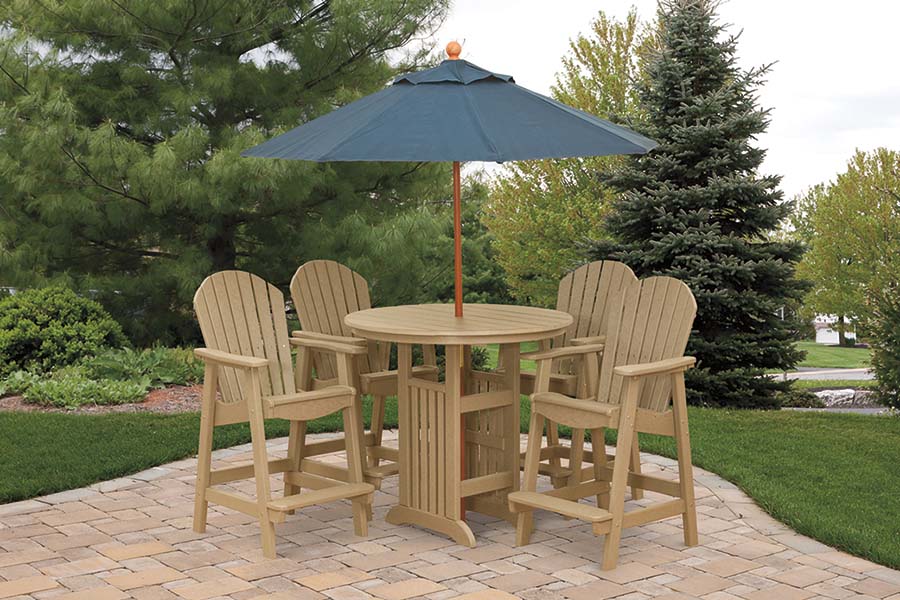Choices are great, but sometimes they can be confusing. A hundred years ago, if you wanted to buy outdoor furniture, you probably had to pick between various chairs made of wood. Today, you have a choice not only in design, but also in materials.
These days, when you’re shopping for outdoor furniture, you can choose from various kinds of metal, plastic, and wood materials. Add in differences in style and design, and the choices are almost endless.
While we can’t make choices for you, we’d like to help you out by comparing furniture made from wood and furniture made from poly lumber. Before we do, we’ll take a minute to talk about poly lumber.
Poly lumber is made from recycled high-density polyethylene (HDPE), the kind of plastic used for milk jugs and detergent bottles. It’s much different—and more durable—than the plastic found in stackable chairs. (For more information, see this info on poly furniture.)

Comparing Wood and Poly
Furniture made from wood and furniture made from poly often looks the same from a distance, but come up close and you’ll notice some differences.
- Look. Wood furniture has a natural grain that varies board-by-board. Up close, you’ll see a blend of similarities and differences. While some poly furniture is smooth, a lot of it is made with “artificial grain” —patterns in the surface of the lumber that mimic the grain found in wood.
- Feel. Wood typically has a rougher texture than poly. Even when it’s been thoroughly sanded and stained or painted, it isn’t as smooth as poly furniture.
- Aesthetics. Poly furniture does a great job of mimicking wood. But (at the risk of stating the obvious) wood furniture is made from wood, and poly furniture is made from plastic. There are some who love wood because it connects them with living things. For them, knowing that furniture is made from “fake wood” can take away some of the joy they have in using it.
- Weight. You won’t know this until you try to move it, but poly furniture is significantly heavier than wood. For most people, this won’t be a disadvantage. In fact, this added weight helps to keep the furniture in place during high winds.
- Price. Though it’s made from recycled material, poly furniture generally costs more than wood. This extra up-front money, however, is offset by the many extra years you can expect from poly.

Advantages of Poly over Wood
- Poly is naturally wear-resistant. Unlike most woods, poly lumber doesn’t need a treatment or coating to protect it from the elements. Unless wood furniture is made from cedar or another rot-resistant wood, wood lumber needs to be saturated with preservatives or it needs an exterior finish (like paint or stain) to keep it from deteriorating. Most poly lumber has a UV-inhibitor added during the manufacturing process, and that is the only treatment that is ever needed.
- Poly requires less maintenance. Because poly is naturally resistant to the elements, there is very little that needs to be done to maintain it. It can sit outdoors year-round in any kind of weather and continue to look great year after year. And, if anything is required, it is rarely more than wiping it down with soap and water.
- Poly tends to be more comfortable. With a smooth, gentle feel, poly just naturally feels better to sit in. It tends not to absorb heat as much as wood, and it certainly won’t give splinters like wood often does.

- Poly ages better. Most poly furniture comes with a decades-long warranty because it tends to last for decades. Due to the way that it’s made, the colors go all the way through, and with the UV inhibitors that are added in manufacturing, there is little need to worry about fading or discoloration in the years that you’ll own it.
- Poly is better for the environment. For a variety of reasons, poly wins the eco-friendly game.
- Manufacturing. There are fewer production costs with making furniture from poly lumber. It costs less to transport the raw materials and to work with them. In addition, all the scraps generated in manufacturing can be melted down and used for the next batch of furniture.
- Inherent durability. Since plastic naturally “lasts forever,” there is no need to inject it with chemical preservatives or coat it with other chemicals. This means a reduction in the use of these materials—which means fewer of these chemicals need to be produced.

- Recycling. Since poly furniture is made from waste plastic, working with it keeps garbage out of landfills and median strips, instead putting it to useful purposes.
- Saving trees. The lumber from which most wood furniture is made comes from renewable forests that are managed like cropland. In the long run, cutting down these trees and replacing them is part of the cycle of life. That said, by using poly for furniture, trees can be left to stand a few years longer or they can be cut and their lumber used in places where plastic just won’t do.
So what do you think?
In the end, the choice is yours. You will be making an investment in your outdoor furniture, and you’ll be the one enjoying it. So if cost is a factor, or if the thought of real wood is a must, then choose wood. But if you’re looking for inherent durability, longevity, and easy maintenance, pick poly.
